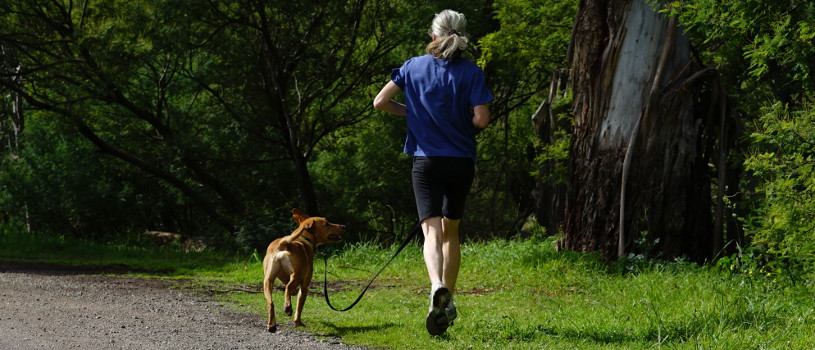The dog on the end of my 5-metre lead has her head buried in the long grass on the river bank. While she is busy sniffing intensely at something clearly irresistible, I watch the ducks watching us. A lycra-clad woman strides past at high speed on the bitumen footpath. The dog on the end of her lead, which is kept tight and short, is prevented from lowering his head. As he is pulled along, the dog keeps craning his neck to look back at us while the woman is busy texting on her phone. Spot the difference? I am walking a dog whereas the other woman is exercising with her dog. These are two very different activities and one cannot replace the other.
Ensure your dog is able and willing
It would be a saint who has never pulled a dog along on a lead, if only for a moment, but the fact that I met the same woman 30 minutes later on the other side of the river, still walking in the same manner with a still very uncomfortable looking dog, made me wonder: Just how many of those people I see frequently running or marching along with their dogs in tow truly consider their dog’s welfare and enjoyment? Forcing a dog to exercise with you isn’t so different from using confrontational training methods. It is about making decisions for the dog and assuming they can handle it.
Making decisions on behalf of another individual carries risks. You may have the capability to push through a challenging physical activity without compromising your health because you have direct feedback from your brain. But you cannot know how your dog is coping until you get feedback from them. Unfortunately by then it could already be too late. Dogs do not show pain and discomfort the way we do and by the time you notice something is wrong, it could be dangerously wrong.
But apart from being risky, it is also simply unfair to impose an activity on a dog without making sure they are actually ok with it. You may think it’s good for them, but as humans we have a limited capacity to decide what is or isn’t good for dogs. The best way to make good decisions for your dog is to learn about dog behaviour and welfare from reputable sources that draw from scientific research. Know your dog’s limitations and learn to read and correctly interpret their body language so you can make the right decisions at any time.
Know your dog’s fears and keep them safe
It is not just about the physical side of things. Of course not every dog is suited for fast walking or running. Breed, age and health are the usual suspects, but there’s more. An often neglected factor is your dog’s mental health. For example, if your dog is fearful of strangers, is afraid of other dogs, suffers from general anxiety or has a noise phobia, they won’t enjoy the exercise if it exposes them to any of their triggers. Worse, they may become more sensitised, making their problems worse. If your dog is not comfortable amongst crowds or in certain environments, change the time or location of your exercise regime.
Do not force your dog to “face their fears” as this will almost certainly backfire. While there is clearly the benefit of exercise on mental health, you need to be well informed to keep your dog feeling safe. Dogs who are not relaxed in specific situations need to be systematically desensitised (and ideally counter-conditioned), not thrown into the deep end. Humans may be able to handle “being pushed” as they can rationalise what is happening (although this too can go horribly wrong). A dog will simply be terrified if they are over-exposed to the things they fear. Don’t risk it. Always let your dog decide if they want to be part of a certain activity.
Give your dog “sniffing time”
Dogs need the – ideally daily – opportunity to experience the outside world from a dog’s perspective. At the very least they need to explore and sniff at things and they may need time to find a good toilet spot. But to stay mentally and emotionally happy, dogs also need to be allowed to follow their natural impulses, as long as it’s safe. Be it rolling in the grass or splashing in a puddle, there are many things that are important activities for dogs but are often dismissed or disliked by us.
If your idea of “taking the dog for a walk” is to power along at a steady pace without stopping, then you are ignoring your dog’s needs. Your dog will be much happier to exercise with you if you also give them the opportunity to do their own thing. This may mean separating “walking the dog” from “exercising with the dog” and do each at different times of day. Or you could start at “sniffing speed”, during which you proceed at your dog’s pace and stop when they want to sniff or have a toilet break, before you switch gears when your dog is ready.
If you find your dog frequently wants to stop while you are running or power walking with them, don’t just drag them along. Instead, consider if your dog is really suited to be your exercise partner or if there might be some other activity you can share and that your dog is more comfortable with.
Teach your dog to keep a loose leash
Problems can also arise when your dog is so enthusiastic that they charge ahead and pull you along. It is unpleasant and the resulting lopsided running style can cause injuries over the long term for both of you. If your dog hasn’t learned to run on a loose leash and pay attention to you, they are likely to change direction or change speed without warning. I once somersaulted through the air because my dog darted right in front of me at high speed. Another time I delivered a similar shock to a dog when she suddenly slowed down causing me to accidentally step on the slack leash. Fortunately we all got away without injuries but it’s best to avoid the chance of collisions and other accidents to begin with.
Before you take your dog running, teach them loose leash walking. Then spend some short runs to practise the same at higher speed, using the same rules as for walking. Praise your dog profusely as long as they keep the leash loose (you don’t need treats here if your dog was trained well to walk on lead), give a warning when they speed up (e.g. “easy”) and stop when the leash tightens. It is a good idea to use cues, such as “let’s go”, “slow down”, “this way” to alert your dog of your intentions. If you want your dog to be your successful running partner, invest some time to develop their skills. Be fair, be a team player.
Increased exercise is one of the great benefits that humans get from having a dog. Those pleading canine eyes and a wiggly butt are much harder to ignore than a “note to self”. Dogs are the perfect allies to combat our sedentary way of life and help us get fitter, healthier and even more social. But if we are too focussed on our own agenda, we can easily overlook that our dogs may not be having fun at all. No matter if you take your dog for a leisurely stroll, a power walk or a run, always make sure it’s right for both of you.
RESOURCES
Running With Your Dog: How to Train Fido to Run at Your Side, by Dr Sophia Yin
Turning Your Dog Into Your Workout Partner, by Dr Karen Becker, in Huffington Post
Ready, Set, Go: Running With Your Dog, by Mikkel Becker, vetstreet
Loose Leash Walking, by Lousiana SPCA
 Copyright secured by Digiprove © 2015 Sylvie Martin
Copyright secured by Digiprove © 2015 Sylvie Martin 
